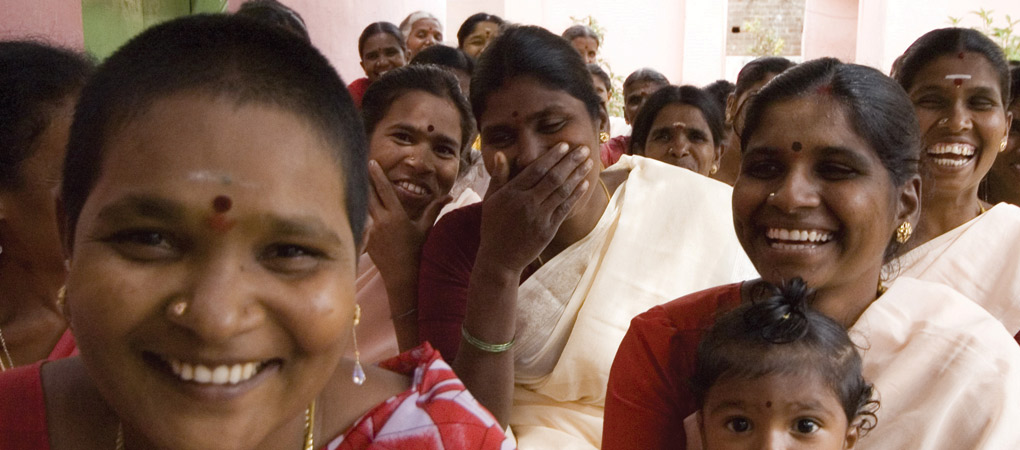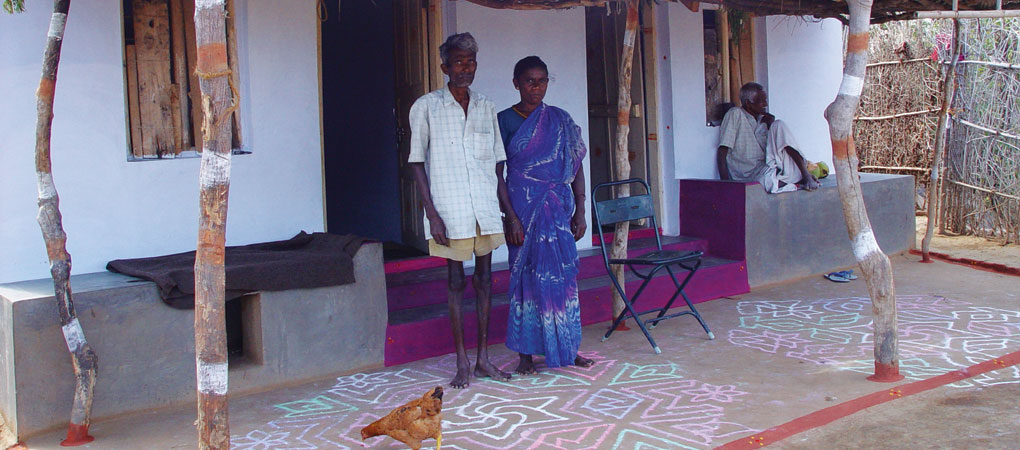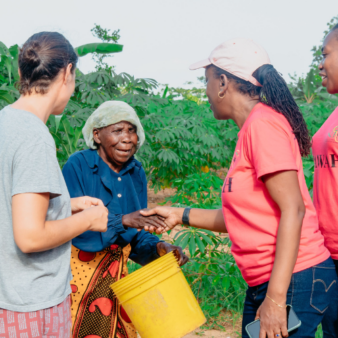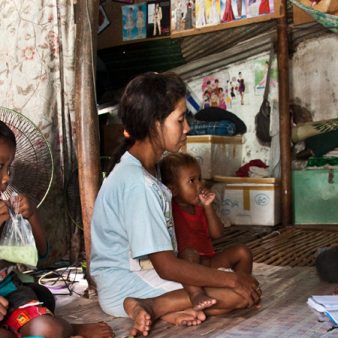Established in 1979, the Integrated Village Development Project (IVDP) is a not-for-profit organisation working in Tamil Nadu, India to improve the living conditions of both the urban and rural poor. IVDP’s work is built around mobilising poor women to come together to form self-help saving groups (SHG), thereby helping them improve their economic and social position. To date, 6,700 groups have been established, each of which is made up of 12 to 20 disadvantaged women. IVDP has sourced affordable credit lines for the members of the saving groups, enabling the construction of 24,705 houses and 17,000 toilets. Awareness-raising campaigns help improve wider vulnerable groups’ understanding of water, sanitation and personal hygiene practices.
Project Description
Aims and Objectives
The main aim of IVDP’s housing and toilet project is to support the 120,000 SHG members to construct adequate housing and toilets and to improve their earning capacities, through awareness raising, provision of training, access to affordable finance and technical support.
Context
Housing is a serious problem in the Krishnagiri and Dharmapuri districts, which have populations of approximately 1.3 million and 1.5 million respectively. In both districts, 80 per cent of the population live in informal housing and less than 15 per cent of households in rural areas and 20 per cent in urban areas have adequate housing, with less than ten per cent having access to a toilet. Homes are typically old, small and overcrowded, and lack adequate lighting, ventilation, water supply, toilet and kitchens, proper drainage and waste disposal systems. Cattle are often housed in one of the rooms of the house or tied up nearby. Surveys in the area showed that between 60 and 80 per cent of all illness was due to inadequate water and sanitation. Due to limited sanitation and personal hygiene options, women in particular are affected by tuberculosis, leprosy, filariasis, skin infections and cervical cancer. The conventional housing development industry only meets the needs of high income households who can afford the services of architects and engineers and are able to access affordable housing finance.
Key features
IVDP’s work is built around mobilising poor women to come together to form savings groups, thereby helping them improve their economic and social position. A huge network of 6,700 SHGs has been established, each of which is made up of 12 to 20 disadvantaged women living below the poverty line. Members of the individual SHGs meet and save regularly, using their savings fund to provide loans for housing, emergencies, school fees and other local priorities. Women within the SHGs develop managerial and administrative skills, whilst building a sense of group solidarity, self-confidence and an enhanced social status within their villages. The SHGs have so far saved over INR 1.3 billion (US$27.7 million) i.e. US$230 per person and accessed loans worth INR 12.4 billion (US$265 million) i.e. US$2,208 per person. Using a specific Indian policy, IVDP supports the SHGs to access credit from their pooled savings directly from local banks and IVDP itself, which channels larger loans from local banks.
To date approximately 24,705 houses and 17,000 toilets have been constructed, with households typically building their homes first and adding a toilet later. Houses and toilets are made of local brick and cement, with the houses ranging in size from 35 m2 to 112 m2, depending on the financial position of the household. A house costs between INR50,000 to INR200,000 (US$1,074 – US$4,294) and a toilet costs approx INR 5,000 to INR10,000 (US$107 – US$215).
Large scale campaigns raise the awareness of SHG members and their families on issues relating to water, sanitation and personal hygiene practices. Toilet exhibitions have been held in marketplaces to motivate people to construct and use toilets. Training is given to local masons on low cost technologies to upgrade their housing and toilet construction skills. Educational activities include running an IT training centre and supporting nursery- and primary-level education of tribal children.
Covering costs
SHG members can access a variety of loan funds for housing and toilet construction including SHG savings, bank loans, and bulk group loans via IVDP. Loans made to date are INR 6.3 billion (US$134 million) from SHG savings, INR 5.8 billion (US$124 million) from four national banks loans and INR 310 million (US$6.6 million) via IVDP. Sixty per cent of the construction cost is usually borrowed and the remaining 40 per cent is sourced from savings. Labour is covered by the SHG households in money and/or in kind. Bank loans carry an interest rate of between 10.0 and 12.5 per cent over a five year period.
Homeless International supports IVDP’s work through grants and bank guarantees. The grants cover part of IVDP’s core costs and enable it to expand the SHG network. It costs IVDP INR 6,276 (US$136) to support each new SHG during its first year or until it becomes self sustaining. SHG contributions also support IVDP running costs through its membership fees and the fees charged on bank loans to the SHG network. This fund is used for strengthening and expanding the network.

Impact
The availability of loans for house and toilet construction have improved the living conditions and health of participating families. SHG members’ incomes have increased with the support of income-generating loans helping them to repay their housing and toilet construction loans ensuring the future availability of loans and increasing women’s self esteem. The project has been able to address poverty, sickness, illiteracy, as well as economic dependency of the women on men.
Why is it innovative?
- Building a strong and financially sustainable network of successful women’s self-help groups which now counts 120,000 members.
- Engaging with the Indian government policy development processes to ensure that billions of rupees reach the poorest women in Southern India.
- Collaborating with banks to ensure the provision of affordable loans and bank guarantees ,which ensure an uninterrupted loan facility.
- Changing people’s behaviour through training and raising awareness on housing-, water- and hygiene-related issues.
- Working with private firms and negotiating discounts on purchases made from them.
- Upgrading the skills of masons in low cost technology for construction, thus making their services available to the people.
What is the environmental impact?
- Locally available building materials are used for house and toilet construction such as bricks and cement for walls, reinforced concrete, local tiles or cement sheets for roofs and cement/tiles for floors. Local wood is used for windows, doors and roofing.
- With the construction of houses and toilets, surrounding areas are ecologically safer. Toilets are equipped with individual septic tanks and therefore prevent the contamination of the soil and ground water. Private washing spaces mean that local rivers and ponds are not used for personal hygiene.
Is it financially sustainable?
- The housing and toilet programme will continue to be financed from the current sources, providing affordable credit to SHG members.
- Currently the network of 120,000 SHG members has saved an equivalent of 1.3 billion INR (US$27.7 million) which will continue to provide funds and leverage credit for ongoing work and dividends to members.
- SHG members have been able to access loans to start small businesses such as mat weaving, poultry rearing, preparing foodstuffs, making toffee, brick making etc., thereby improving their economic position and enabling them to take on larger loans for housing and toilet construction.
- Housing and toilet construction helps to generate employment for local masons and to provide for 119 new masons.
- Discounts provided by private companies on their various products have amounted to INR40 million (US$867,000).
- Training masons in low cost building technology, bulk procurement and transportation of materials brings down the costs considerably.
What is the social impact?
- Social sustainability and community empowerment are central features of IVDP’s work. The regular fortnightly SHG meeting of the 12 – 20 women members helps to build community solidarity, as well as increasing the women’s confidence and self-esteem, enabling them to play a greater role within their communities. SHG leaders are chosen by the members and many of these also go on to become village local government (panchayat) leaders.
- Community and panchayat leaders are mobilised and trained in issues of safe water, sanitation and personal hygiene and then pass on the knowledge to other SHGs members. To date, over 6,000 SHG leaders have been trained.
- The skills of masons have been upgraded thanks to the training in low cost housing and toilet construction.
- Women have greater privacy with the construction of individual household toilets and sanitation has improved as a result of the awareness raising. Health indicators have improved, with a survey in 2008 showing that 94 per cent of SHG members did not experience any water- or sanitation-related sickness. Household income on medical expenses has been reduced.
- To date, 47,250 water filters and millions of sanitary towels have been purchased by SHG members at discounted prices, improving health indicators and raising awareness of the dangers of using more traditional methods.
- The role and status of women has increased significantly both within and outside their communities. The women are now less dependent on men economically, take on greater responsibility within society and exude confidence. Female children are now educated and child marriage/early marriage practices have virtually ceased.
Barriers
- Identifying beneficiaries was difficult at first but was overcome by IVDP through home visits and meeting SHG members.
- There was a shortage of masons and this was addressed by inviting masons from neighbouring areas.
- Some banks delayed releasing the housing and toilet loans to SHG members. This was settled through discussions and negotiations with the banks.
- There were delays in the transportation of construction materials to remote areas but special vehicles were arranged for this purpose.
Lessons Learned
- Houses and toilets should not be built during the rainy season as this interrupts the construction process. The construction should be completed within a stipulated timescale.
- Constant monitoring and supervision is necessary until the projects are complete.
- Awareness raising activities must be undertaken with SHG members before the start of construction, in order to retain their motivation and to improve their sanitary practices.
- Training should be given to local masons on low cost construction technology.
- Bulk purchasing of construction materials from centralized suppliers reduces the costs.
- Loans should be made available to SHG members at regular intervals and not in one lump sum. Stringent loan repayment measures must be enforced to ensure good repayment rates and future availability of loans. Repayment periods should be between two to five years both for toilet and housing loans.
- Project beneficiaries must be encouraged to pursue income generating activities so that they can repay their loans.
Evaluation
Internal and external periodic evaluations are conducted in order to understand the impact and limitations of the project. After the construction of the houses and toilets an external body evaluates the work. Independent external teams that have conducted monitoring and evaluation exercises include Homeless International, the Sacred Heart College in Tirupattur and Holy Cross in Bangalore.
Transfer
The project has influenced government policy in respect of banking practice, since the four nationalised banks now have the confidence to give large loans to SHGs and are happy to lend money at a rate that is one per cent less than available to other customers, due to the excellent repayment rates.
With 120,000 households in 6,700 SHGs, the number of SHGs is an outstanding feature of this project. Some members of IVDP staff, after having gained knowledge, training and techniques from IVDP have now set up their own NGOs and replicate the model.
Local NGOs such as SPEED, the Bosco Institute of Social Works and SEARCH are involved in similar programmes. They frequently visit IVDP and continue to learn and follow the model.
National and international: IVDP shares experience from coordinating the programme at the International Network of Alternative Financial Institutions.
Partnership
Local community, Private sector



